Hi Jeep owners! I’m Andy and today I’m going to talk about shocks. So, the idea is to explain the difference between different styles of Shocks for Jeep JK, TJ and how to replace shocks on your Jeep. You have a very simple, inexpensive damper to a much more complex, much more expensive damper. When should you buy them? What set-up are they suitable for? When is it worth spending two to three times as much on Shocks for Jeep XJ? And that’s what I’m really going to deepen and explain today. Alright, let’s jump right in and see how to choose shocks for your Jeep Wrangler!
So, in order to find out how Shocks for Jeep JK, TJ are and what they feel differs, it’s better to install a set of three different jeeps, put them on the road, and take them off-road as well. Today we will discuss three different shocks. So, something that is a bit more of a simple damper is the TeraFlex 9550. And up to the Falcon 2.1, this will be a monotube design and then the Falcon 3.3 which is an adjustable design with a surge tank. When it comes to the TeraFlex 9550, it definitely comes from an on-road world. This means that the performance is limited. That doesn’t mean it doesn’t do as well as it does on the roads, as you know, crawling rock, where speeds are slower. Well, if you’re a person who is not that into absolute performance, high speed off-road, high speed on the road, and if you crawl, then maybe that’s fine with you. If you are going down a gravel road you want a nice ride but you aren’t really interested in sawing or jumping or doing something crazy, this is a good choice. But if someone is looking for a little more performance they can upgrade to Falcon 2.1 and it will be different in many ways. Someone who’s really into high spirited road driving, faster off-road speeds, you know, high spirited driving that you aren’t all that interested in adjustability should be looking at this 2.1 versus the 9550.
Oftentimes people see the shock and think it’s pretty much the same size between these three. We will see that they are fundamentally different sizes. And that’s something you can see in the cutaways, so this is the 9550 and this is a 2.1 and the butt size. If you’re wondering why it is beneficial to have a much larger piston area, the answer is simple! It has a lot to do with pressure. For example, if this is 100 pounds of force it might be 100 PSI, but as we get bigger we get 100 pounds of force here. This may only be 25 PSI. This works at a lower pressure and by working at lower pressures we can create higher forces without damaging the damper and we will talk about the piston there because that is your damper. This is where the work is done, this is where the ventilation is, this is the character of your shock absorber. Simply put, that works with a 2.1 and that works with the twin tube. Well, it’s a dramatic size.
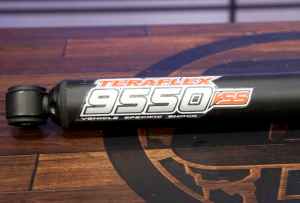
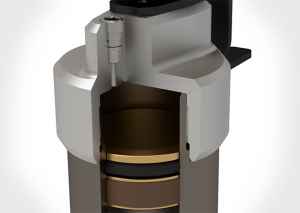
If you ask what kind of person will want to go up to an adjustable 3.3 over 2.1, my answer is the following. The adjustability allows you to forego a little comfort for top performance. If we turn this up and you walk through a pile of stones, it gets a little firmer. But if you drive it through it really fast it won’t punch through, you have more vehicle stability on a nice smooth sidewalk. By turning up this damping, you get a very spirited performance, less body roll, good handling, and the nice thing is when you get on a road and say, “Yeah, that’s a little rough,” you just turn it down. So, this is soft. And the other way is firm. So here it’s adjustable between soft and tight depending on what you want, and then all you have to do is remind yourself that I want number two and that’s it. You can obviously not change the number of these valves inside or the thickness of the valve stack. But what actually to do when you turn this knob? So, if it’s the wide-open position or one, we have a bottom valve. The oil that flows through the bottom valve is the oil that is displaced by the shaft. When that gets into that chamber it has to go somewhere and we open a check valve that bypasses the base valve completely. This is the same when it is in one. But when we split it in two we close the check valve so we push oil through that piston and we have a vent so it changes size.
But when we turn it up to the max, all the oil has to go through the valves and there is no bypass at all. Well, the main body still has the same ventilation as the 2.1. What changes in the adjustability is this additional valve, which is located in the additional reservoir. So, if you have the budget for it, if you want the adaptability, you want something that is very easy to set up and also very easy to use, I think this will be an excellent option for you.
But what I’m actually going to discuss now is the action of putting a set of each of these three shock absorbers on three different Jeeps, driving them on the road first and then off-road so I can really help you tell the difference in explaining the real world between each of these three different shocks. Well, I set different shock absorbers, the 9550, the 2.1, and the 3.3 on the jeep at the end there I could do some real-world tests and I could give you an idea of the different feeling you get from these different shock absorbers.
Well, the Jeeps are a bit different as far as the rest of the chassis setup goes. The first jeep and the one at the end have about a 3-inch lift and a 37, the blue one has a 2-inch lift and a 35. So, the chassis setup has a little effect on the ride quality. But what I was going to try is the ride quality you get from the shock absorbers and the different feeling of really filtering out, not so much from the rest of the suspension. So, let’s get into the Jeep with the 9550 and let’s get started.
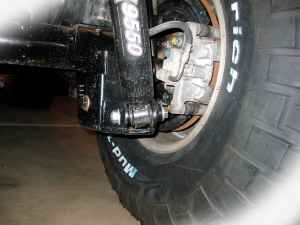
But that big body shock will really dissipate that heat much better and overtime will do a much nicer job even at these speeds, so definitely a big difference between the 9550 and what I felt with the 2.1. And finally, the last Jeep I drove off-road and this one had the Falcon 3.3 shock absorbers. So, this had the adaptability and I was going to do it in all three different settings so I could really feel the difference. So, these 3.3s were currently in adaptation one. This makes them feel a lot like the 2.1s, like the non-adjustable shock absorbers. And then of course when you go to the twos and threes you get a little stiffer. Now where you want that stiffness is if you ride a little more spirited on the road you want a little less body roll, that will give you, but also if you ride a little higher speed off-road, you want a little bit more stiffness, because that actually gives you a little more control over the vehicle. So, if you proceed kindly and slowly this way, you can really be in any environment you want. You won’t notice much of a difference when you slow down, but in one you do get this really soft, soft feeling. When you hit it at a bit more speed on the way back it feels a lot like the 2.1s. It’s pretty comfortable, it’s pretty soft. It’s a little floating. When I drive around bends, I feel a bit of this body role again, just like with the 2.1s. I am pointing this out again because I really want to be able to feel the difference and be able to feel the differences between this setting and setting two and setting three.
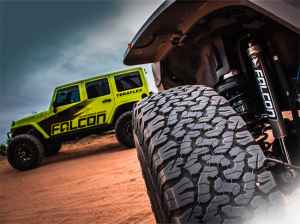
To give you a little more control when you’re traveling off-road at higher speeds, you can actually place the Jeep where you want it to be, and when you go around those corners it’ll stay nice and flat, nice and neutral for They and really give you the chance to really blast around out here and have fun at some of those higher speeds. So, you feel it a little more. You feel the road a little more. You feel the trace. It stays nice and flat around the corner. Again, you may not think you would feel that much of a difference, but you really do. So that’s a nice moderate setting, but knowing we have one more thing, a bit more stiffness, especially if we’re really trying to get things done with some speed here, we really want a nice flat ride. We want this maximum of control, that’s what three are for. So, let’s make that switch. Well, I’m going to go ahead and put all of this in setting three. This will be the stiffest setting so I can really feel the road.
When I get up to speed it will really help reduce a lot of body roll and give me a lot of control over fast off-road driving. If you compare it to the 2.4, if you compare it to the one, it already feels a lot stiffer. On the road, I know from experience, this definitely reduces body tilt. I’m looking forward to doing a little more speed off-road but feeling a little stiffer. But it definitely gives you more control when you go fast on the road and off-road. That’s what this attitude is about. You definitely feel a bit more of every bump again, certainly not uncomfortable, but I have the feeling that I can go faster, even around these corners on this snow, I just feel more confident. There is definitely a significant difference between 1 and 3 and even between 2.4 and 3. There is much more control for you when you are three in that setting. So, I drove three different Jeeps with three different sets of shock absorbers and there was a big difference between all three.
Which shock is best for you now? It depends on many different factors. How your Jeep is set up apart from the shock absorbers, what you plan to do with your Jeep and what budget you have. If you’re on a budget, if you’re going slow off-road and on-road, there’s really nothing wrong with a properly ventilated twin-tube damper. It’ll do the job. It will do whatever you need to. If you want to drive at higher speeds off-road, then opt for a high-quality monotube damper. You can handle a lot more jolts, a lot more jerk speed, and a lot more pressure. It’ll be better all round for driving off-road at higher speeds. And if you’re someone looking for a damper that offers maximum travel and still has a nice little compressed length, then these balance shocks are what you should look into. Even if you’re just going slower off-road, reservoir shocks can still be beneficial as this reservoir allows for longer stroke for a longer travel shock while still having a nice little compressed length and when you step onto a reservoir, this is adjustable too, it really gives you the best of both worlds. A long travel damper, a soft and comfortable damper if you wish, gives you the freedom to go anywhere from the center to a nice stiff and controlled ride. It will give you maximum.
In this article I compared a twin-tube damper, a high-quality single-tube damper and an adjustable damper with a reservoir. There are many manufacturers who make many different shocks, but hopefully this information will help you make your next purchase decision easier. Keep in mind that you can find all the information about Shocks for Jeep JK, TJ and Shocks for Jeep XJ on my website. Drive safely!
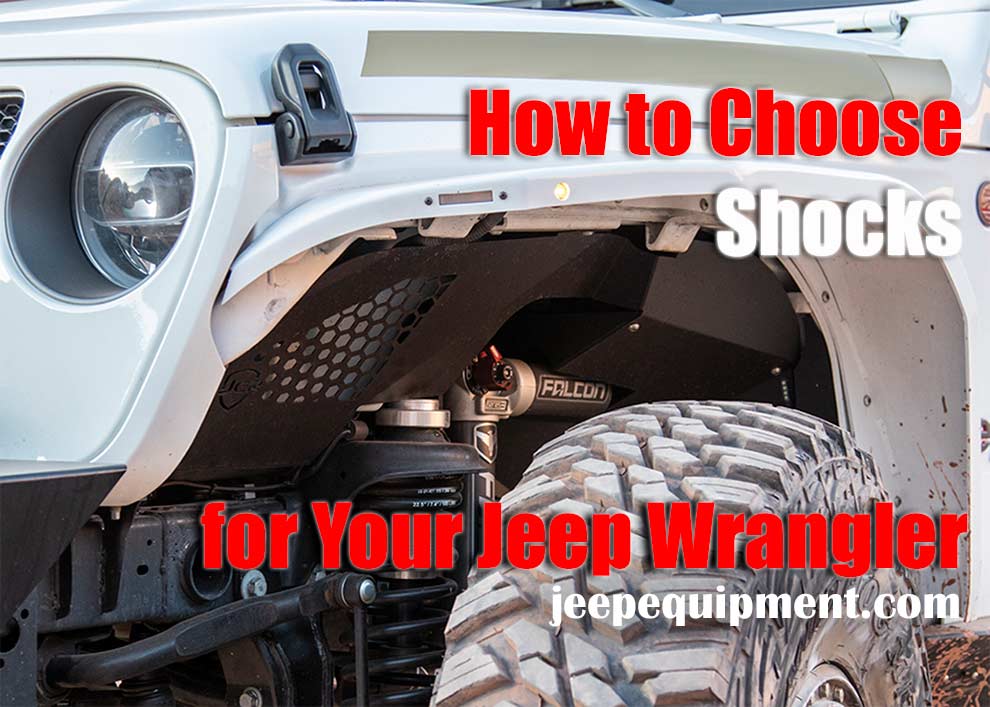

Add Comment